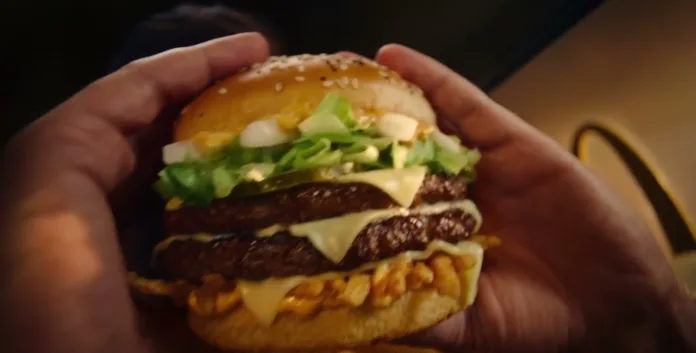After years of premium burger flops, McDonald’s is testing a new, more satisfying take on its classic Big Mac across three international markets.
McDonald’s is once again aiming to crack the premium burger market with a new offering—The Big Arch. This latest creation is being piloted in three international markets, as the fast-food giant looks to deliver a more filling and satisfying burger to its loyal customers.
The move comes after a history of failed attempts to introduce premium burgers, including notable flops like the Arch Deluxe and Angus Burger. While previous efforts didn’t resonate with customers, McDonald’s management, led by CEO Chris Kempczinski, believes The Big Arch could be the solution.
The Big Arch builds on the familiar flavours of the iconic Big Mac but with a few significant enhancements. It features two beef patties layered with melting cheese, crispy toppings, and the brand’s signature tangy sauce, offering customers a burger that not only satisfies but provides great value for money.
Kempczinski has avoided labelling the burger as a premium offering, instead emphasizing value and customer satisfaction. During McDonald’s second-quarter earnings call, the CEO stressed the company’s commitment to improving its core menu. This includes the “Best Burger” initiative, which aims to improve overall taste through subtle changes like softer buns, caramelized onions, and more Big Mac sauce.
As McDonald’s pilots The Big Arch, the company hopes to learn from this trial period before expanding the offering to more international markets by the end of the year. The fast-food chain is betting that its new burger, designed to provide a more satiating meal, will break its streak of premium burger failures.
Analysis:
Political:
From a political perspective, McDonald’s new attempt at a premium burger speaks to the challenges faced by corporations when navigating consumer preferences in different regions. With the introduction of The Big Arch in three international markets, the company has strategically avoided the U.S. market for this pilot, reflecting an understanding of the political and cultural nuances that shape food consumption habits. Food regulation standards, market competitiveness, and varying economic conditions across these markets make this a calculated move. By testing in international markets first, McDonald’s is likely to gauge how different consumer groups will respond before rolling it out globally.
Social:
Socially, McDonald’s has always had an influential role in fast food culture worldwide, and the launch of a new premium-style burger reflects a broader trend towards more gourmet offerings in the quick-service restaurant industry. Consumers have increasingly sought out higher-quality, more filling meals that provide better value for money, and McDonald’s is trying to meet that demand with The Big Arch. The burger could also be seen as a way for McDonald’s to adapt to the ongoing “burger wars,” where competitors like Shake Shack and Five Guys have raised the bar for fast food hamburgers, pushing legacy brands to innovate. This push for a more satiating burger is also indicative of a shift towards mindful eating, where consumers want meals that provide a satisfying experience rather than just a quick bite.
Racial:
McDonald’s success with The Big Arch in international markets may depend on how well the company adapts its product to the diverse cultural and racial makeup of its global customer base. The ingredients and flavours in the new burger are familiar to those who enjoy the classic Big Mac, but local preferences will need to be taken into account. For instance, beef consumption is culturally sensitive in some countries, while the flavor profile of the burger may need to be adjusted to cater to regional palates. McDonald’s history of customizing its menu to local tastes—like offering the McSpicy Paneer in India or the Teriyaki Burger in Japan—suggests that if The Big Arch is to succeed, it must be flexible and inclusive in its offerings.
Gender:
Gender dynamics in fast food marketing often go unnoticed, but McDonald’s introduction of The Big Arch could reflect a subtle shift in targeting a more gender-inclusive audience. Historically, fast food advertising has sometimes skewed towards a male demographic, particularly with “big” or “filling” menu items that appeal to stereotypical notions of hearty, masculine meals. However, with modern consumers—both men and women—increasingly concerned about value and satisfaction, The Big Arch could be McDonald’s effort to appeal across genders by offering a burger that provides both indulgence and practicality. The focus on familiar flavours also suggests that McDonald’s is not trying to alienate any gendered food preferences but instead offering something universally enjoyable.
Economical:
Economically, McDonald’s decision to introduce The Big Arch is a strategic move aimed at navigating the competitive fast-food landscape while maintaining a price point that emphasizes value. With inflation impacting consumer spending habits, McDonald’s focus on a more “satiating” burger reflects an understanding of customer demand for meals that are both affordable and filling. CEO Chris Kempczinski’s emphasis on value plays into the broader industry trend of “premium for less,” where fast-food chains offer higher-quality products without significantly raising prices. This economic model could prove successful for McDonald’s, particularly in international markets where economic conditions vary, and customers are increasingly budget-conscious. The introduction of The Big Arch during a time of economic uncertainty could position McDonald’s as a brand that delivers more for less, setting it apart from higher-priced competitors.
